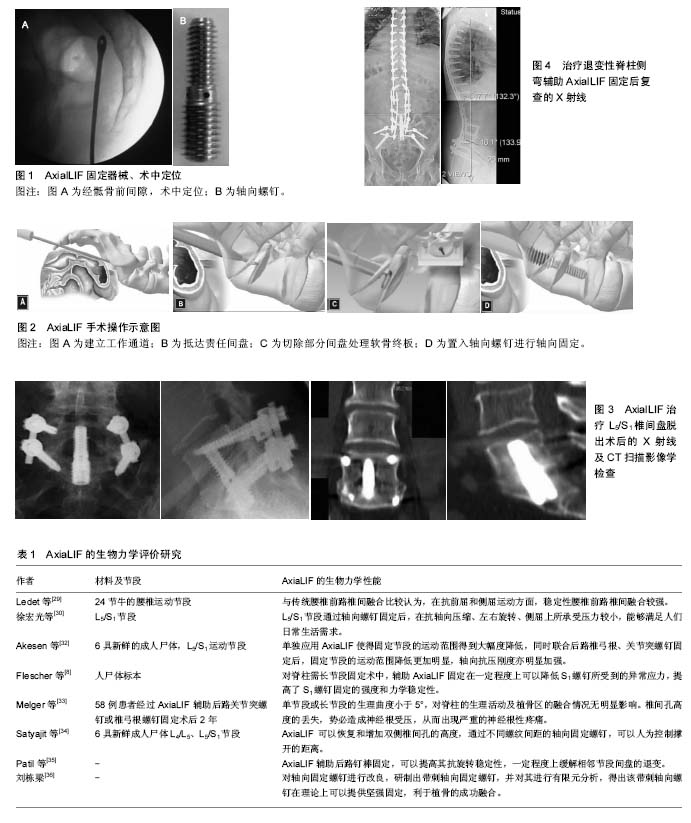| [1] Gerszten PC, Tobler WD, Nasca RJ. Retrospective analysis of L5-S1 axial lumbar interbody fusion (AxiaLIF): a comparison with and without the use of recombinant human bone morphogenetic protein-2. Spine J. 2011;11:1027-1032.[2] Vibert BT, Sliva CD, Herkowitz HN. Treatment of instability and spondylolisthesis: surgical versus nonsurgical treatment. Clin Orthop Relat Res. 2006;443:222-227.[3] Chen D, Fay LA, Lok J, et al. Increasing neuroforaminal volume by anterior interbody distraction in degenerative lumbar spine. Spine (Phila Pa 1976). 1995;20:74-79.[4] Vamvanij V, Ferrara LA, Hai Y, et al. Quantitative changes in spinal canal dimensions using interbody distraction for spondylolisthesis. Spine (Phila Pa 1976). 2001;26:E13-E18.[5] Cragg A,Carl A,Casteneda F. New percutaneous access method for minimally invasive anterior lumbosacral surgery.J Spinal Disord Tech. 2004;17(1): 21-28.[6] Marotta N, Cosar M, Pimenta L, et al. A novel minimally invasiveresacral approach and instrumentation technique for anterior L5-S1,intervertehral discectomy and fusion. Neurosurg Focus. 2006;20(1):E9.[7] Aryan HE, Newman CB, Gold JJ, et al. Percutaneous axial lumbar interbody fusion (AxiaLIF) of the L5-S1 segment: initial clinical and radiographic experience. Minim Invasive Neurosurg. 2008;51(4):225-230.[8] Fleischer GD, Kim YJ, Ferrara LA, et al. Biomechanical analysis ofsacral screw strain and range of motion in long posterior spinal fixation constructs:effects of lumbosacral fixation strategies in reducing sacral screw strains. Spine. 2012;37(3): 163-169.[9] 戎利民,董健文,刘斌,等. 轴向椎体间融合术微创治疗腰骶椎失稳症[J]. 中华显微外科杂志,2009,32(1):15-18.[10] 宋西正,王文军,薛静波,等. 经骶前间隙轴向椎间融合联合内窥镜下后入路椎间盘摘除治疗腰骶椎退行性疾病[J]. 中国脊柱脊髓杂志,2013,23(9):778-782.[11] 宋西正. 经骶前间隙轴向椎间融合术联合显微内窥镜下后入路椎间盘摘除治疗腰骶椎退行性疾病[A]. 中国中西医结合学会脊柱医学专业委员会、《中国骨伤》杂志.中国中西医结合学会脊柱医学专业委员会第五届学术年会暨第二届专业委员会换届选举会议论文集[C].中国中西医结合学会脊柱医学专业委员会、《中国骨伤》杂志,2012.[12] Burns BH. An operation for spondylolisthesis.Lancet. 1933;1: 1233.[13] Vamvanij V, Ferrara LA, Hai Y, et al. Quantitative changes in spinal canal dimensions using interbody distraction for spondylolisthesis. Spine (Phila Pa 1976). 2001;26: E13-E18.[14] Fantini GA, Pappou IP, Girardi FP, et al. Major vascular injury during anterior lumbar spinal surgery: incidence, risk factors, and management. Spine (Phila Pa1976). 2007;32: 2751-2758.[15] Hsieh PC, Koski TR, O’Shaughnessy BA, et al. Anterior lumbar interbody fusion in comparison with transforaminal lumbar interbody fusion: implications for the restoration of foraminal height, local disc angle, lumbar lordosis, and sagittal balance. J Neurosurg Spine. 2007;7:379-386.[16] Fantini GA, Pappou IP, Girardi FP, et al. Major vascular injury during anterior lumbar spinal surgery: incidence, risk factors, and management. Spine (Phila Pa 1976). 2007;32: 2751-2758.[17] Sasso RC, Kenneth Burkus J, LeHuec JC. Retrograde ejaculation after anterior lumbar interbody fusion: transperitoneal versus retroperitoneal exposure. Spine (Phila Pa 1976). 2003;28: 1023-1026.[18] Cloward RB.The treatment of ruptured lumbar intervertebral discs by vertebral body fusion: indications, operative technique, after care. J Neurosurg. 1953;10:154-168.[19] Jutte PC, Castelein RM. Complications of pedicle screws in lumbar and lumbosacral fusions in 105 consecutive primary operations. Eur Spine J. 2002;11(6):594-598.[20] DiPaola CP, Molinari RW. Posterior lumbar interbody fusion. J Am Acad Orthop Surg. 2008;16:130-139.[21] Pimenta L. Lateral endoscopic transpsoas retroperitoneal approach for lumbar spine surgery. VIII Brazilian Spine Society Meeting.[22] Silvestre C, Mac-Thiong JM, Hilmi R, et al. Complications and morbidities of mini-open anterior retroperitoneal lumbar interbody fusion: oblique lumbar interbody fusion in 179 patients. Asian Spine J. 2012; 6(2): 89-97.[23] Kubota G, Orita S, Umimura T, et al. Insidious intraoperative ureteral injury as a complication in oblique lumbar interbody fusion surgery: a case report. BMC Res Notes. 2017;10:193.[24] Yeung AT. The evolution of percutaneous spinal endoscopy and discectomy: state of the art.Mt Sinai J Med. 2000;67: 327-332.[25] Foley KT, Holly LT, Schwender JD. Minimally invasive lumbar fusion. Spine. 2003;28(15S):S26-S35.[26] Xue H, Tu Y, Cai M. Comparison of unilateral versus bilateral instrumented transforaminal lumbar interbody fusion in degenerative lumbar diseases. The Spine J. 2012;12(3): 209-215.[27] Chen HH, Cheung HH, Wang WK, et al. Biomechanical analysis of unilateral fixation with interbody cages. Spine. 2005;30(4): E92-E96. [28] Suk KS, Lee HM, Kim NH, et al. Unilateral versus bilateral pedicle screw fixation in lumbar spinal fusion. Spine. 2000;25(14): 1843-1847.[29] Ledet EH, Tymeson MP, Salerno S, et al. Biomechanical evaluation of a novel lumbosacral axial fixation device. J Biomech Eng. 2005;127(6): 929-933.[30] 徐宏光,杨晓明,吴天亮,等.经皮前路腰骶融合螺钉的有限元分析[J].中华医学杂志, 2010, 90(3): 153-156.[31] Erkan S, Wu C, Mehbod AA, et al. Biomechanical evaluation of a new AxiaLIF technique for two-level lumbar fusion. Eur Spine J.2009;18(6):807-814.[32] Akesen B, Wu C, Mehbod AA, et al. Biomechanical evaluation of paracoccygealtranssacral fixation. J Spinal Disord Tech. 2008;21(1):39-44.[33] 戎利民,董健文,刘斌,等. 轴向椎体间融合术微创治疗腰骶椎失稳症[J]. 中华显微外科杂志, 2009, 32(1): 15-18.[34] Marawar S, Ordway N, Jung J, et al. Changes in neuroforaminal height with 2 level axial presacral lumbar interbody fusion at L4-S1. J Spine Surg. 2014.[35] Patil SS, Lindley EM, Patel VV, et al. Clinical and radiological outcomes of axial lumbar interbody fusion. Orthopedics. 2010;33(12):883.[36] 刘栋梁.腰骶椎带刺内锁轴向融合内固定的有限元分析[D].南华大学,2017.[37] Tobler WD, Ferrara LA. The presacral retroperitoneal approach for axial lumbar interbody fusion: a prospective study of clinical outcomes, complications and fusion rates at a follow-up of two years in 26 patients. J Bone Joint Surg Br. 2011; 93: 955-960.[38] Tobler WD, Gerszten PC, Bradley WD, et al. Minimally invasive axial presacral L5-S1 interbody fusion: two-year clinical and radiographic outcomes. Spine (Phila Pa 1976). 2011;36:E1296-E1301.[39] Gerszten PC, Tobler W, Raley TJ, et al. Axial presacral lumbar interbody fusion and percutaneous posterior fixation for stabilization of lumbosacral isthmic spondylolisthesis. J Spinal Disord Tech. 2012;25:E36-E40.[40] Anand N, Baron EM, Thaiyananthan G, et al. Minimally invasive multilevel percutaneous correction and fusion for adult lumbar degenerative scoliosis: a technique and feasibility study. J Spinal Disord Tech. 2008;21:459-467.[41] Issack PS, Boachie-Adjei O. Axial lumbosacral interbody fusion appears safe as a method to obtain lumbosacral arthrodesis distal to long fusion constructs. HSS J. 2012;8: 116-121.[42] Botolin S, Agudelo J, Dwyer A, et al. High rectal injury during trans-1 axial lumbar interbody fusion L5-S1 fixation: a case report. Spine (Phila Pa 1976). 2010;35:E144-E148.[43] Mazur MD, Duhon BS, Schmidt MH, et al. Rectal perforation after AxiaLIF instrumentation: case report and review of the literature. Spine J. 2013;13:e29-e34.[44] Hofstetter CP, Shin B, Tsiouris AJ, et al. Radiographic and clinical outcome after 1- and 2-level transsacral axial interbody fusion. Clinical article. J Neurosurg Spine. 2013;19: 454-463.[45] Marchi L, Oliveira L, Coutinho E, et al. Results and complications after 2-level axial lumbar interbody fusion with a minimum 2-year follow-up. Clinical article. J Neurosurg Spine. 2012;17:187-192.[46] 邱贵兴. 以人为本,发展骨科[J]. 中华外科杂志, 2009, 47(1): 4-6. |
.jpg)

.jpg)